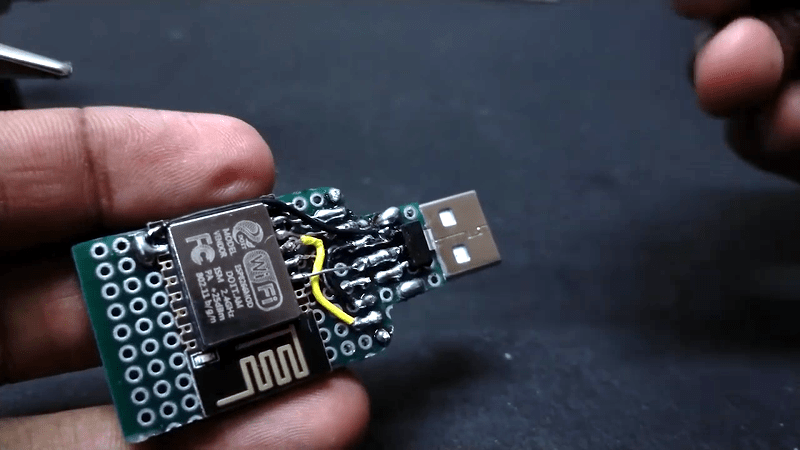You can find commercial USB sticks that can also connect via WiFi. But [Neutrino] made his own using an ESP8266 married to a card reader. It all starts with the old trick of soldering a header to an SD card adapter. The USB port is still there, but it is only for power. A 3.3 V regulator and an ESP12E board round out the hardware.
Of course, the trick is the software. Starting from a few examples, he wound up providing an FTP server that you can connect to and send or receive files using that protocol.
It sounds like a few design compromises led to the device being somewhat slow, although it looked usable. [Neutrino] wants to change to the ESP32 and make some other changes to get better speeds.
Of course, you could go buy a SanDisk Connect Wireless or similar product, but what fun is that? Besides, being able to connect an SD card to your project opens up a lot of possibilities for data logging, configuration, and more.
Honestly, we’ve had relatively poor results with most of the commercial wireless memory offerings including the venerable FlashAir, so it is attractive to have a device that you can completely control. If you have an SD card connected to a project, one thing you can do is play some tunes.
















Awesome idea )))) cooooooool
And now, just add a battery, charging and protecting circuit to make a totally wireless one…
Add wireless charging too
Sounds like reinventing the Zsun SD-100 without OpenWrt and by dimensions slower, less hackable, but not much cheaper. But ok, the Zsuns seem to vanish now. Maybe the Eaget(?) branded ones really are perfect clones but I never dared to try.
—▷ https://openwrt.org/toh/zsun/wifi-card-reader
Have a look at Whitecat’s Lua. It’s a whole OS on ESP32 with shell and editor and may be a good start to implement all this in a very flexible and hackable(!) way.
—▷ https://github.com/whitecatboard/Lua-RTOS-ESP32
It’s the wireless sd cards that need hacking – I’ve been trying to find one that I can stick in the 3d printer and send gcode’s to.
AFAIK the device needs to support SDIO protocols…. so that would be the printer controller side that needs hacking… which probably means it’s easier just to wire the 8266 to it rather than go through the card interface.
Yes, that’s the problem. The printer would need a reset to see the file also.
At that point you might as well stick a Raspberry-pi zero-w onto it with something like octoprint.
Sure, it’s overkill, but at least it’s flexible.
The wifi scards like eyefi run linux and share the storage area independently, the wireless capability is not inherited by the host https://hackaday.com/tag/eye-fi/
To get your device to see a new firmware file you’d need to toggle an eject and inject
I had been using a Tocshiba FlashAir 8GB SD card in my Deltaprintr to do just that. In my browser, I can open a page on the SD card then drag and drop a file to it. Then just print as normal. But I found it pretty slow, so, for the last couple of years, I just pull the card out and plug it into my Mac.
There was info on the net somewhere on how to set it up.
This may help….
http://microfabricator.com/blogs/view/id/54e438e56983c5316480205e/using-a-flashair-wifi-enabled-sdcard-with-your-3d-printer
Do you need to reset the printer after the files change? I have to reset mine if I take out the card, obv no way to monkey with the files while it’s mounted. I’m thinking I need a smartplug as well. The Toshiba cards are on the expensive side, I messed with EZ-share which also has the problem of only supporting image files. Found one for $60, I could buy 3 pairs of sneakers for that. It might be worth it if I wore more expensive sneakers.
The original Deltaprintr runs a modified Marlin firmware and, in my experience, doesn’t require a restart to see new files when you reinsert the card. It appears to fetch the card contents each time you open the file selection screen on the control panel. I can’t speak for their later Delta Go model.
Have you considered Octopi/Octoprint?
https://octoprint.org/download/
Wireless control *and camera monitoring* of prints has been quite handy, the software is mature, and the time/material costs for Octoprint are close to those of a custom wireless SD approach. Integration with chat clients like Telegram make it easy to monitor and cancel a failed print from outside your home network as well.
Bud bud try out
I carry a PQI Air Card (microSD to SD and WiFi) and an EspUSB in my pocket, stashed in the back of an iPod 5.5G (HDD replaced by SSD).
This would be a great way to reduce the number of adaptors I carry! I’ll need to build the code for Esp8285 instead of Esp8266, but it looks like a very realistic project. A WiFi keyboard & mouse, and SD card reader, all inside a USB port – that sounds amazing.
The only Esp8266 project I’m surprised I haven’t seen yet is an FM radio transmitter. I know it’s possible with RPi GPIO, so I guess it could be done with an ESP.
https://hackaday.com/2013/12/07/super-simple-fm-transmitter/#comment-1126015
$3 gets you very good transmitter with arduino already onboard
Physical size is important to me though; the EspUSB fits inside a USB plug, and that’s a major plus for me. I have too many “pocket-sized” devices for my pockets.
looks like the subzero nas project
https://hackaday.com/?s=subzero
there is now MAYPOLE, see linked page